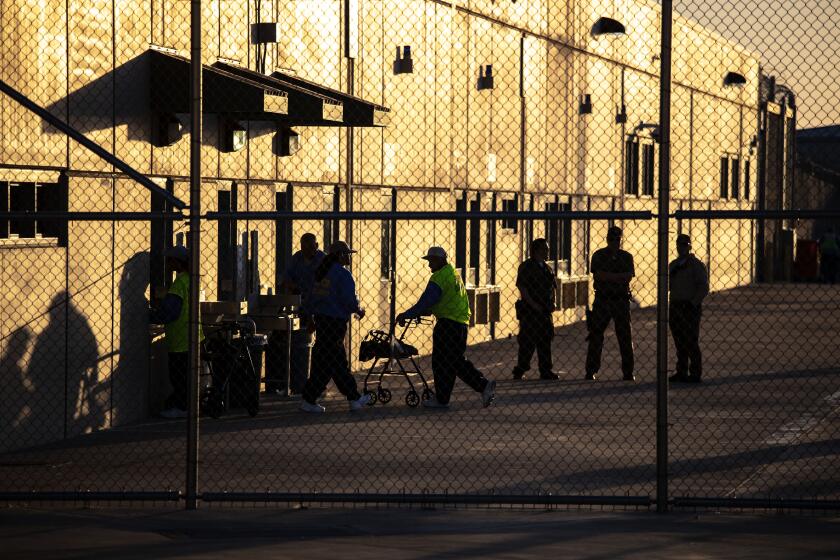Teacher Sal Castro fights to honor the Eastside ‘blowouts’
- Share via
Sal Castro sat in his book-lined den, reduced to writing on a whiteboard to fight what could be his last political battle.
Hours earlier, the “usually glib and gregarious” teacher and activist, as he describes himself, had been released from St. Vincent Medical Center with a serious illness that made it difficult for him to speak. But Castro insisted on meeting with me to express his frustration with President Obama.
Since 2009, Castro has been trying to get the president, first lady or Vice President Joe Biden to come to Boyle Heights to honor the students of the Eastside walkouts of 1968. At the height of the civil rights movement, Castro, then a young teacher at Lincoln High, walked out with his students to protest schools that set up Mexican Americans to fail. The walkouts, or “blowouts” as they came to be known, spread to five Eastside high schools, then throughout the Southwest.
Castro, now 78, believes the blowouts should be seen as the equivalent of black civil rights touchstones like the Selma march or the lunch-counter sit-ins. To him, they jump-started the whole Chicano rights movement. The White House imprimatur, he believes, would elevate the walkouts to their proper place in history.
“This is about civil rights,” Castro wrote on his board. “That’s why we want him here.”
As we spoke, I wondered if Castro wasn’t being presumptuous, or at least naive. On Monday, Obama’s two-day swing through Southern California took him to Keene in Kern County, where he dedicated the Cesar E. Chavez National Monument, the first such site to honor a contemporary Mexican American. Castro had asked him to squeeze in a second ceremony to dedicate a plaque for the Eastside students at Hazard Park near County-USC Medical Center, where they had gathered during the blowouts.
If it took so long for the first Mexican American to receive that presidential recognition, what were the chances of a second commemoration? Obama has the California Latino vote in the bag; the Chavez dedication is a national play. The president can’t be everywhere, especially during a tough reelection campaign.
Castro, though, has mixed feelings about Chavez’s legacy. He’s happy he’s being honored but also feels the labor leader’s monolithic stature has overshadowed the struggles of city Latinos who derived no benefit from the farmworker fight.
“Cesar Chavez unionized 16,000 farmworkers,” Castro wrote on his little board. By contrast, 48,000 students marched in the blowouts. “Farmworkers are no threat,” he wrote.
After the walkouts, Castro was arrested and held for five days. He was slapped with several felony conspiracies, his teaching credential was threatened and he was jerked around by the L.A. Unified school district. But eventually, he landed back in the classroom at Belmont High, where he continued to press for student rights until his retirement in 2004.
Castro is keenly aware that the school district still struggles to educate kids from Spanish-speaking families. Latinos continue to lead the nation in high school drop-out rates and teen pregnancies, and bright students are tracked away from college prep courses.
He showed me a letter he wrote Obama in 2009 protesting the lack of progress and questioning the administration’s educational reforms
“I don’t think merit pay for teachers and charter schools will help very much. Do you?” he wrote.
He waved another letter he had written, taking Obama to task for an education speech arguing that children need a parent at home to turn off the TV and help with the homework. To Castro, the remarks ignored the economic reality for Latino parents, many of whom must work long hours away from their kids.
“There you go again Mr. President,” Castro wrote. “I know you didn’t mention our community by name but whites thought they knew who you were talking about.”
Yet Castro supports the president and had a fat Obama-Biden button pinned to his T-shirt during our exchange. He also wore a “Yellow Dog Democrat” button, which I was told means he would vote for a yellow dog before a Republican.
The president doesn’t have to come to the dedication himself, but Castro is adamant that it be someone of national stature. To that end, he has written inviting the president twice, Michelle Obama twice, Biden once, Secretary of State Hillary Clinton once and former President Clinton once.
Michelle Obama wrote back once declining his invitation. He has never heard from the president.
It’s not as if Sal Castro has no political juice. Bill Clinton had him to the White House in 1996; and in 2010, Salvador B. Castro Middle School was dedicated on the Belmont campus.
The walkouts produced a new generation of Latino professionals and politicians who are aware of the debt they owe Castro and the blowout students. Politicians like L.A. Mayor Antonio Villaraigosa, who attended Castro’s Latino youth leadership program. “I helped Tony when he was 15 get into UCLA,” Castro said. Villaraigosa said Monday he backed federal recognition for the memorial.
The plaque honoring the students is ready, a rock at Hazard Park has been prepared to receive it and local politicians are ready at a moment’s notice, Castro said.
Castro refused to have his name on the plaque. This one is for the students, he said.
More to Read
Sign up for Essential California
The most important California stories and recommendations in your inbox every morning.
You may occasionally receive promotional content from the Los Angeles Times.













